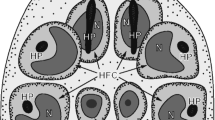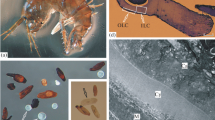Abstract
The ultrastructural features of the development of Hemolivia mariae, a blood parasite of the Australian lizard, Tiliqua rugosa, from sporokinetes to sporozoites in their vector tick Amblyomma limbatum are described. Sporokinetes, released from oocysts, re-establish themselves in tick-gut epithelial cells within a parasitophorous vacuole, the wall of which becomes evaginating and anastomosing and is underlined extensively by endoplasmic reticulum. The sporozoites forming within the encysting sporokinete body become bordered by a prominent thick wall, which eventually forms the resistant sporocyst wall. The main differences between the ultrastructural features of Hemolivia and those of other hemogregarine taxa are discussed.
Similar content being viewed by others
Author information
Authors and Affiliations
Additional information
Received: 1 October 1999 / Accepted: 14 December 1999
Rights and permissions
About this article
Cite this article
Smallridge, C., Paperna, I. Ultrastructure studies on post-oocyst development of the lizard hemogregarine Hemolivia mariae in the tick Amblyomma limbatum . Parasitol Res 86, 467–471 (2000). https://doi.org/10.1007/s004360050695
Issue Date:
DOI: https://doi.org/10.1007/s004360050695




